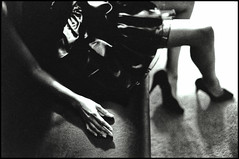Abstract
Reading Pynchon Rewriting
Luc Herman
The canonization of Thomas Pynchon as the American postmodernist author of the 1960s and 70s has been partially enhanced by his perceived invisibility, which functioned as one of the main proofs of Foucault’s and Barthes’s suggestion that a writer was by no means in control of his own writing. While the paradoxical notion of perceived invisibility doesn’t mean at all that Pynchon is a total mystery—the author can be reached fairly easily through his wife, the literary agent Melanie Jackson, and a few years ago he even consented to a fax interview for a biography on one of his friends (Hajdu 2001)—he has been toying with this image up to the present day. In January 2004, he lent his voice to an episode of The Simpsons in which he appeared as a “famous reclusive author” with a brown paper bag over his head. However, Pynchon has definitely been quite serious in trying to cover up certain aspects of his personal and professional life. In the early 1990s, his lawyers managed to block access to an application he had submitted with the Ford Foundation in 1959 (Weisenburger 1991), and in 1998 they successfully took on the Pierpont Morgan Library, which had acquired a cache of letters to his former agent, Candida Donadio. It was hardly surprising then that genetic criticism on Pynchon, apart from two articles (Fowler 1984; Patteson 1984) about the transformation of his early short story, “Under the Rose” (1962) into chapter three of his first novel, V. (1963), did not amount to much. The typescript of V. acquired by the Harry Ransom Center at the University of Texas (Austin) in 2000 radically changed this critical impasse. The 685 page typescript is a first version of the novel and contains more than a 100 pages eventually removed from the text. Pynchon cannot prevent people from seeing this remarkable object since it is the property of the Ransom Center.
As a long-standing Pynchon critic I took a natural interest in this typescript and am currently working on a series of articles about it. My purpose in this paper is to take a step back from my own research practice so as to consider the politics of genetic criticism dealing with an author who has been eager to cover up all his traces apart from his publications. The typescript obviously reinserts the biographical author Thomas Pynchon into the critical equation. “Should” this lead to a more profound understanding of certain ideological issues related to his first novel, and allow us to “correct” already existing interpretations, or “should” it rather, in an effort to avoid the pitfalls of critical arrogance, be seen as merely one approach among many? In my answer to this question, I will focus on how the character of the black jazz musician in V., McClintic Sphere, is stripped in the novel’s final version of various characteristics indicative of Pynchon’s stand on race at the beginning of his literary career.
Thanks, Rich!



